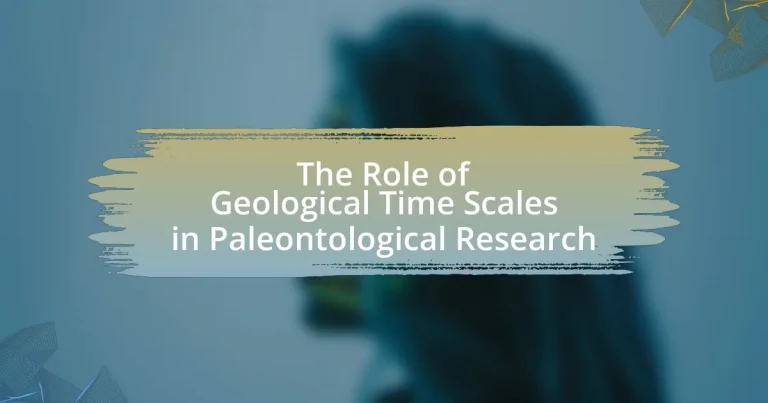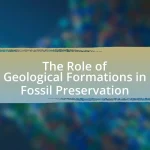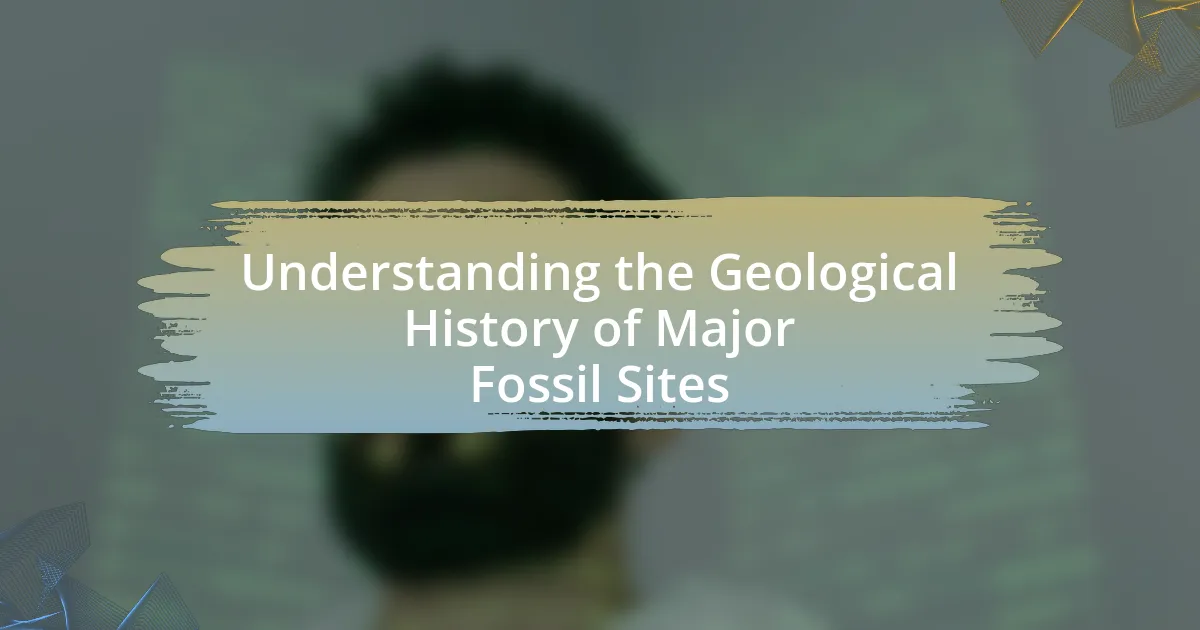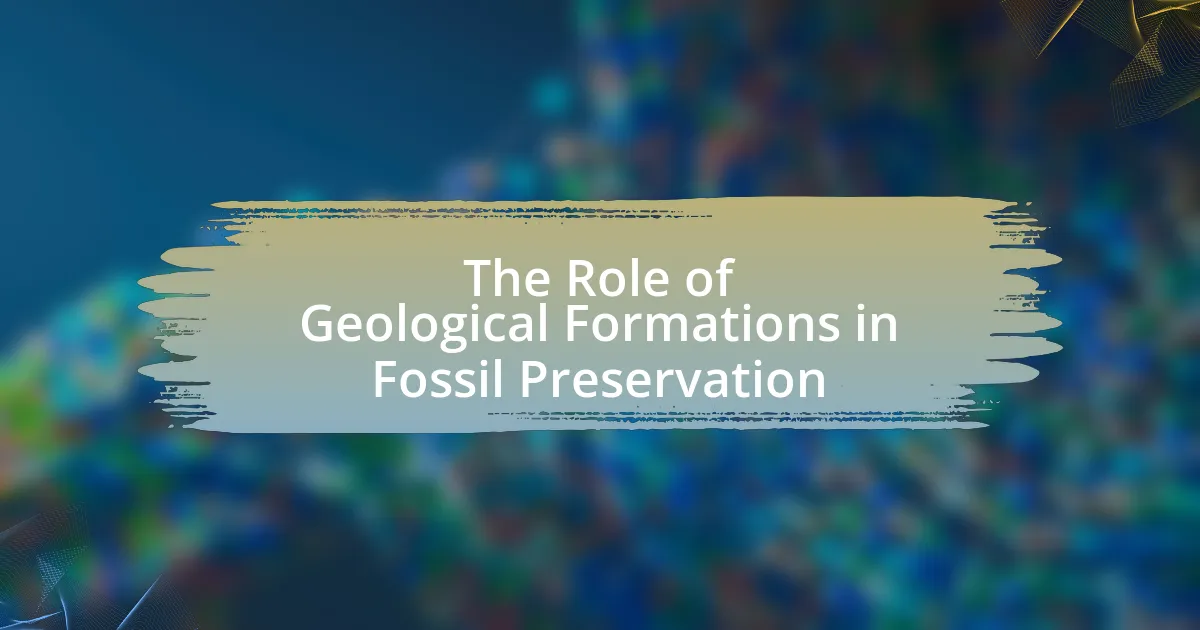Geological time scales are essential frameworks in paleontological research, providing a structured timeline for understanding Earth’s history and the evolution of life. They enable scientists to date fossils, correlate them with specific geological periods, and study evolutionary patterns and extinction events. Key divisions of geological time, including eons, eras, periods, and epochs, correspond to significant biological and geological milestones, such as the Cambrian Explosion and mass extinctions. Methodologies like radiometric dating and stratigraphy are employed to establish these time scales, which are crucial for accurately interpreting fossil records and understanding evolutionary processes. Challenges in correlating geological data and discrepancies in dating highlight the complexities of this field, while advancements in technology promise to enhance the accuracy of geological time scales in future research.
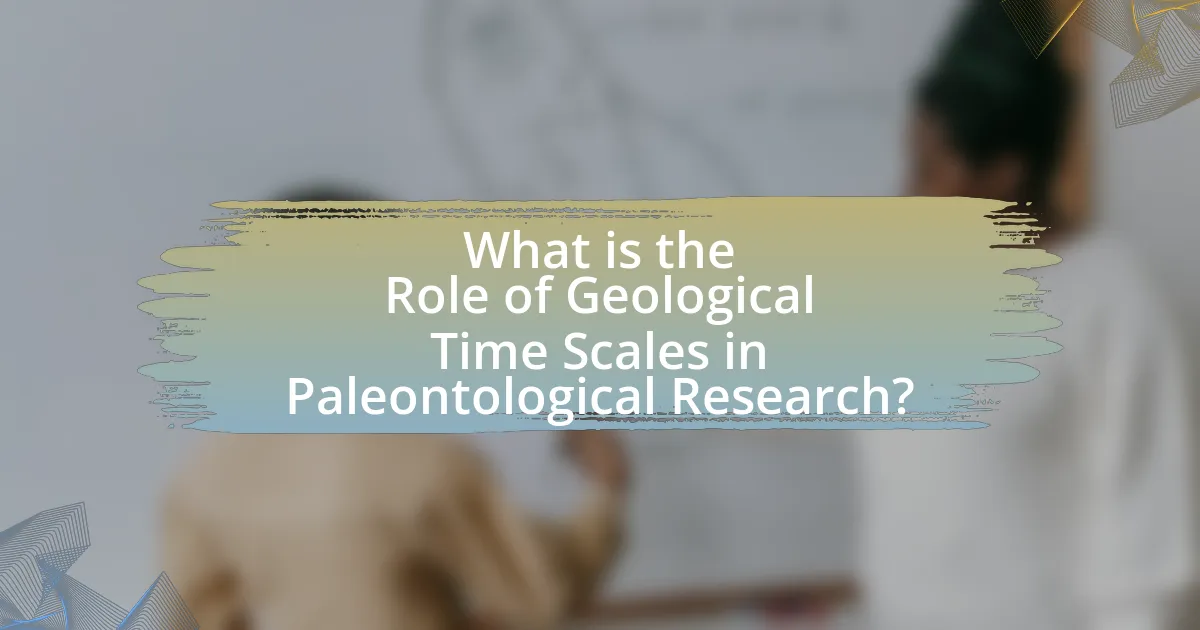
What is the Role of Geological Time Scales in Paleontological Research?
Geological time scales play a crucial role in paleontological research by providing a framework for understanding the chronological sequence of Earth’s history and the evolution of life. These time scales allow paleontologists to date fossils and correlate them with specific geological periods, facilitating the study of evolutionary patterns and extinction events. For instance, the division of geological time into eras, periods, and epochs enables researchers to identify when particular species existed and how they adapted to changing environments over millions of years. This structured timeline is essential for reconstructing past ecosystems and understanding the dynamics of biodiversity through time.
How do geological time scales influence our understanding of Earth’s history?
Geological time scales provide a framework for understanding Earth’s history by categorizing significant geological and biological events over vast periods. These scales allow scientists to date rock layers and fossils, revealing the sequence of life forms and environmental changes, such as the Cambrian Explosion approximately 541 million years ago, which marks a rapid diversification of life. By correlating fossil records with geological strata, researchers can trace evolutionary lineages and extinction events, such as the mass extinction at the end of the Cretaceous period around 66 million years ago, which led to the demise of the dinosaurs. This structured timeline enhances our comprehension of Earth’s dynamic processes and the evolution of life, illustrating how organisms have adapted to changing environments over millions of years.
What are the key divisions of geological time scales?
The key divisions of geological time scales are eons, eras, periods, epochs, and ages. Eons represent the largest time intervals, with the Phanerozoic being the most recent, spanning from approximately 541 million years ago to the present. Eras are subdivisions of eons; for example, the Phanerozoic is divided into three eras: Paleozoic, Mesozoic, and Cenozoic. Each era is further divided into periods, such as the Jurassic and Cretaceous within the Mesozoic. Periods can be subdivided into epochs, like the Holocene and Pleistocene within the Quaternary period. Finally, epochs can be divided into ages, which represent the smallest time intervals in the geological time scale. This hierarchical structure allows for a detailed understanding of Earth’s history and the evolution of life.
How do these divisions relate to major events in Earth’s history?
Geological time scales categorize Earth’s history into distinct divisions, such as eons, eras, periods, and epochs, which correspond to significant geological and biological events. For instance, the Mesozoic Era, known as the Age of Reptiles, includes the Triassic, Jurassic, and Cretaceous periods, during which dinosaurs dominated the planet and the breakup of the supercontinent Pangaea occurred. These divisions help scientists understand the timing and sequence of major events, such as mass extinctions, like the Cretaceous-Paleogene extinction event approximately 66 million years ago, which marks the boundary between the Mesozoic and Cenozoic eras. By studying these divisions, researchers can trace evolutionary changes and environmental shifts that have shaped life on Earth throughout its history.
Why are geological time scales essential for paleontological studies?
Geological time scales are essential for paleontological studies because they provide a framework for understanding the chronological sequence of Earth’s history and the evolution of life. This framework allows paleontologists to accurately date fossils and correlate them with specific geological periods, facilitating the study of evolutionary patterns and extinction events. For instance, the Cambrian period, which began around 541 million years ago, marks a significant increase in the diversity of life forms, known as the Cambrian Explosion, which is crucial for understanding the development of complex organisms. By utilizing geological time scales, researchers can also identify the environmental conditions that influenced evolutionary changes, thereby enhancing our comprehension of biological and ecological dynamics throughout Earth’s history.
How do time scales help in dating fossils?
Time scales assist in dating fossils by providing a chronological framework that categorizes geological and biological events over Earth’s history. These scales, such as the geologic time scale, divide time into eons, eras, periods, epochs, and ages, allowing scientists to correlate fossil findings with specific time intervals. For instance, the presence of certain fossils, known as index fossils, can indicate the age of rock layers, as these organisms existed during specific time frames. This method of relative dating, combined with absolute dating techniques like radiometric dating, enables researchers to establish a timeline for the evolution of life and the age of fossilized remains, thereby enhancing our understanding of biological and environmental changes throughout history.
What role do they play in understanding evolutionary processes?
Geological time scales play a crucial role in understanding evolutionary processes by providing a framework for dating events in Earth’s history and correlating them with biological changes. This framework allows scientists to identify patterns of evolution, extinction, and diversification over time, as evidenced by the fossil record, which is organized according to these time scales. For instance, the Cambrian Explosion, occurring around 541 million years ago, marks a significant increase in the diversity of life forms, illustrating how geological time scales help contextualize major evolutionary milestones.
What methodologies are used to establish geological time scales?
Geological time scales are established using methodologies such as radiometric dating, stratigraphy, and biostratigraphy. Radiometric dating involves measuring the decay of radioactive isotopes in rocks and fossils, providing precise age estimates; for example, uranium-lead dating can date rocks that are billions of years old. Stratigraphy analyzes the layering of sedimentary rocks to understand the relative ages of geological formations, while biostratigraphy uses fossil assemblages to correlate and date rock layers based on the presence of specific fossils, which are indicative of certain time periods. These methodologies collectively enable scientists to construct a comprehensive timeline of Earth’s history and the evolution of life.
What techniques are employed in radiometric dating?
Radiometric dating employs several techniques, primarily including uranium-lead dating, potassium-argon dating, and carbon-14 dating. Uranium-lead dating measures the decay of uranium isotopes into lead isotopes, providing age estimates for rocks over millions of years. Potassium-argon dating relies on the decay of potassium-40 to argon-40, which is useful for dating volcanic rocks and ash layers. Carbon-14 dating, on the other hand, is effective for dating organic materials up to about 50,000 years old by measuring the decay of carbon-14 isotopes. These techniques are validated by their consistent application in geological studies, allowing scientists to construct accurate geological time scales essential for paleontological research.
How do stratigraphic principles contribute to time scale development?
Stratigraphic principles contribute to time scale development by providing a framework for understanding the chronological sequence of geological events through the study of rock layers and their relationships. These principles, such as the Law of Superposition, which states that in undisturbed strata, older layers are found below younger ones, allow geologists to establish relative ages of rock formations. Additionally, the principle of faunal succession indicates that fossil assemblages within these layers can be used to correlate and date strata across different geographic locations. This correlation is essential for constructing a comprehensive geological time scale, as it integrates data from various sites to create a unified timeline of Earth’s history.
How do geological time scales correlate with fossil records?
Geological time scales correlate with fossil records by providing a chronological framework that allows scientists to date and understand the sequence of life on Earth. These time scales are divided into eons, eras, periods, epochs, and ages, which correspond to significant geological and biological events, such as mass extinctions and the emergence of new species. For instance, the Cambrian period, which began around 541 million years ago, is marked by a rapid diversification of life forms, evident in the fossil record through the appearance of various marine organisms. This correlation enables paleontologists to establish timelines for when specific organisms existed, thus facilitating the study of evolutionary patterns and environmental changes over time.
What challenges do researchers face when using geological time scales?
Researchers face several challenges when using geological time scales, primarily due to the inherent complexity and variability of geological data. One significant challenge is the difficulty in accurately correlating rock layers across different geographic locations, which can lead to discrepancies in dating events. For instance, the same fossil may appear in different strata in various regions, complicating the establishment of a universal timeline. Additionally, the incomplete nature of the fossil record poses another challenge, as many organisms did not fossilize, leading to gaps in data that hinder precise chronological interpretations. Furthermore, the reliance on radiometric dating methods introduces potential errors, as variations in decay rates and environmental factors can affect results. These challenges underscore the need for careful analysis and cross-referencing of multiple data sources to construct reliable geological time scales.
How do discrepancies in dating affect paleontological conclusions?
Discrepancies in dating significantly undermine paleontological conclusions by leading to incorrect interpretations of the temporal context of fossil findings. When dating methods yield inconsistent results, it can result in misalignment of species’ evolutionary timelines, potentially suggesting that certain organisms coexisted when they did not. For instance, radiometric dating techniques, such as uranium-lead dating, have shown variations that can alter the perceived age of rock layers, thereby affecting the chronological placement of fossils within those layers. This misdating can mislead researchers about the evolutionary relationships and ecological dynamics of ancient life forms, as evidenced by cases where conflicting dates have prompted reevaluation of established fossil records, such as the debate surrounding the age of the Burgess Shale fossils.
What are the limitations of current geological time scales?
Current geological time scales have limitations primarily due to their reliance on incomplete fossil records and the subjective nature of stratigraphic correlations. Incomplete fossil records can lead to gaps in understanding evolutionary timelines, as certain periods may lack sufficient data to accurately represent species diversity and extinction events. Additionally, stratigraphic correlations often depend on the interpretation of rock layers, which can vary among geologists, leading to inconsistencies in the dating of geological events. These factors contribute to uncertainties in the precise timing and duration of geological periods, impacting paleontological research and the reconstruction of Earth’s history.
What are the implications of geological time scales for future paleontological research?
Geological time scales significantly influence future paleontological research by providing a framework for understanding the temporal distribution of life on Earth. These scales allow researchers to correlate fossil records with specific geological periods, facilitating the study of evolutionary patterns and extinction events. For instance, the identification of the Cambrian Explosion within the geological time scale helps paleontologists investigate the rapid diversification of life forms during that era, leading to insights about evolutionary mechanisms. Furthermore, geological time scales assist in predicting future biodiversity trends by analyzing past climate changes and their impacts on species survival, as evidenced by the mass extinctions recorded in the fossil record. Thus, geological time scales are essential for contextualizing paleontological findings and guiding future research directions.
How can advancements in technology improve geological time scale accuracy?
Advancements in technology can improve geological time scale accuracy by enabling more precise dating techniques and enhanced data analysis. For instance, radiometric dating methods, such as uranium-lead and potassium-argon dating, have become more refined with advancements in mass spectrometry, allowing for more accurate age determinations of rock layers. Additionally, the use of high-resolution geochronology techniques, like laser ablation and inductively coupled plasma mass spectrometry, provides detailed isotopic analyses that can resolve age discrepancies in geological formations. These technological improvements lead to a better understanding of the temporal distribution of fossils and geological events, thereby refining the geological time scale.
What future research directions are suggested by current geological time scale studies?
Future research directions suggested by current geological time scale studies include the refinement of stratigraphic correlations and the integration of high-resolution geochronology techniques. These advancements aim to improve the accuracy of dating geological events and enhance the understanding of biotic responses to environmental changes throughout Earth’s history. For instance, studies utilizing radiometric dating methods, such as uranium-lead dating, have provided more precise age estimates for significant geological formations, thereby allowing researchers to better correlate fossil records with specific time intervals. Additionally, the application of isotopic analysis can shed light on past climate conditions, further informing the relationship between geological time scales and paleontological data.
What best practices should researchers follow when utilizing geological time scales in their studies?
Researchers should ensure accuracy and consistency when utilizing geological time scales in their studies. This involves using standardized time scales, such as the International Chronostratigraphic Chart, to maintain uniformity across research. Additionally, researchers should correlate their findings with established geological events and fossil records to validate their interpretations. For instance, aligning data with the Cambrian explosion or the Cretaceous-Paleogene boundary provides a reliable framework for understanding evolutionary timelines. Furthermore, researchers must document their methodologies and assumptions clearly, allowing for reproducibility and peer review, which enhances the credibility of their work.
